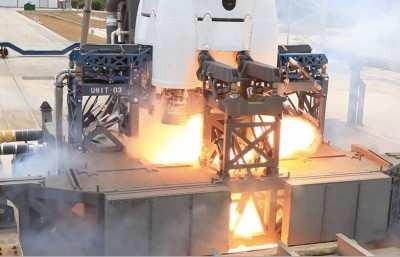Sat, Mar 13, 2010
Weather At Cape Canaveral Delays A Second Attempt
 SpaceX has identified the problem
that led to an abort of this week's planned static engine test of
its Falcon 9 rocket at Cape Canaveral. SpaceX CEO Elon Musk tells
ANN that the problem was a valve that didn't receive a specific
command during the auto-start sequence.
SpaceX has identified the problem
that led to an abort of this week's planned static engine test of
its Falcon 9 rocket at Cape Canaveral. SpaceX CEO Elon Musk tells
ANN that the problem was a valve that didn't receive a specific
command during the auto-start sequence.
"The valve that didn't actuate is the ground side isolation
valve to release ground supplied high pressure helium to start the
first stage engine turbopumps spinning at several thousand rpm,"
Musk told ANN in an e-mail. "Once that happens it generates enough
pressure to start the gas generator, which is a small rocket engine
that powers the turbopump. There are no vehicle side valves
actuated for spin start (just check valves), so it is an all
engines or none situation."

SpaceX Photo
Musk said the problem was pretty simple: the autostart sequence
didn't issue the command to the normally closed ground side
isolation valve. "We had tested everything on the vehicle
side exhaustively in Texas, but didn't have this iso valve on our
test stand there," he said. "Definitely a lesson learned to make
sure that *everything* is the same between test stand and launch
pad on the ground side, not just on the vehicle side."
Musk said that ignition fluid (TEA-TAB) flowed nominally to all
engines creating the green flame and the main valves opened, but no
engines actually started and the system automatically aborted on
lack of spin. "The fire generated was from flushing the system of
fuel and LOX from the open mains. No damage to the vehicle or
ground systems and no other anomalies that need to be addressed,"
Musk said. "If all goes well, we will try the static fire again in
the next few days," he added. Weather at Cape Canaveral, including
the possibility of tornadoes north of the area on Thursday,
prevented another attempt this week.

SpaceX Photo
Musk called the current stage of development on Falcon 9 the
equivalent of "beta testing." "Problems are expected to occur, as
they have throughout the development phase," he said. "The beta
phase only ends when a rocket has done at least one, but arguably
two or three consecutive flights to orbit."
More News
Pilot Also Reported That Due To A Fuel Leak, The Auxiliary Fuel Tanks Were Not Used On June 4, 2025, at 13:41 eastern daylight time, a Piper PA-23, N2109P, was substantially damage>[...]
Have A Story That NEEDS To Be Featured On Aero-News? Here’s How To Submit A Story To Our Team Some of the greatest new stories ANN has ever covered have been submitted by our>[...]
From 2023 (YouTube Edition): Reflections on War’s Collective Lessons and Cyclical Nature The exigencies of war ought be colorblind. Inane social-constructs the likes of racis>[...]
Aero Linx: Colorado Pilots Association (CPA) Colorado Pilots Association was incorporated as a Colorado Nonprofit Corporation in 1972. It is a statewide organization with over 700 >[...]
High Speed Taxiway A long radius taxiway designed and provided with lighting or marking to define the path of aircraft, traveling at high speed (up to 60 knots), from the runway ce>[...]
 NTSB Prelim: Piper PA-23
NTSB Prelim: Piper PA-23 ANN FAQ: Submit a News Story!
ANN FAQ: Submit a News Story! Classic Aero-TV: One Mans Vietnam
Classic Aero-TV: One Mans Vietnam ANN's Daily Aero-Linx (07.03.25)
ANN's Daily Aero-Linx (07.03.25) ANN's Daily Aero-Term (07.03.25): High Speed Taxiway
ANN's Daily Aero-Term (07.03.25): High Speed Taxiway





